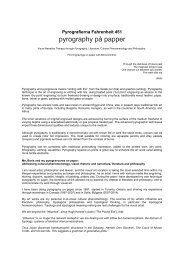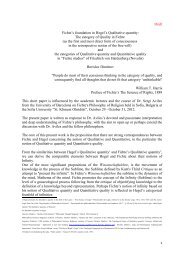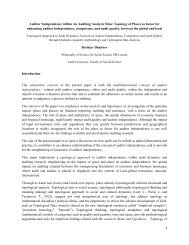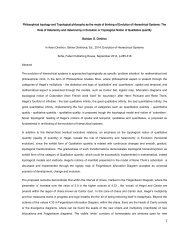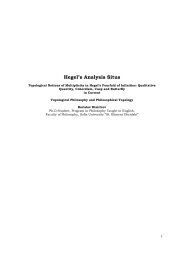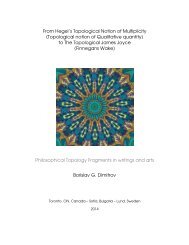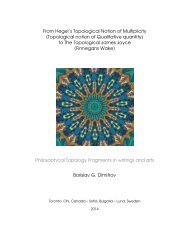Topological Ontology and Logic of Qualitative quantity
Qualitative quantity and BFO (Basic Formal Ontology) of /Barry Smith/ and YAMATO (Yet Another More Advanced Top-level Ontology) of /Riichiro Mizoguchi/
Qualitative quantity and BFO (Basic Formal Ontology) of /Barry Smith/ and YAMATO (Yet Another More Advanced Top-level Ontology) of /Riichiro Mizoguchi/
- No tags were found...
Create successful ePaper yourself
Turn your PDF publications into a flip-book with our unique Google optimized e-Paper software.
homology theory. Eilenberg <strong>and</strong> Mac Lane later wrote that their goal was to underst<strong>and</strong><br />
natural transformations; in order to do that, functors had to be defined, which required<br />
categories.<br />
Categorical logic is a branch <strong>of</strong> category theory within mathematics, adjacent to<br />
mathematical logic but more notable for its connections to theoretical computer science. In<br />
broad terms, categorical logic represents both syntax <strong>and</strong> semantics by a category, <strong>and</strong> an<br />
interpretation by a functor. The categorical framework provides a rich conceptual<br />
background for logical <strong>and</strong> type-theoretic constructions. The subject has been recognisable<br />
in these terms since around 1970.<br />
Categorical logic originated with Bill Lawvere’s Functorial Semantics <strong>of</strong> Algebraic Theories<br />
(1963), <strong>and</strong> Elementary Theory <strong>of</strong> the Category <strong>of</strong> Sets (1964). Lawvere recognised<br />
Alex<strong>and</strong>er Grothendieck’s topos theory, introduced in algebraic topology as a generalised<br />
space, as a generalisation <strong>of</strong> the category <strong>of</strong> sets (Quantifiers <strong>and</strong> Sheaves (1970). With<br />
Myles Tierney, Lawvere then developed the notion <strong>of</strong> elementary topos, thus establishing the<br />
fruitful field <strong>of</strong> topos theory, which provides a unified categorical treatment <strong>of</strong> the syntax<br />
<strong>and</strong> semantics <strong>of</strong> higher-order predicate logic. The resulting logic is formally intuitionistic.<br />
Andre Joyal is credited, in the term Kripke– Joyal semantics, with the observation that the<br />
sheaf models for predicate logic, provided by topos theory, generalise Kripke semantics.<br />
Historically, the major irony here is that in large-scale terms, inuiyionistic logic had<br />
reappeared in mathematics, in a central place in the Bourbaki-Grothendieck program, a<br />
generation after the messy Brouwer-Hilbert controversy had ended, with Hilbert the<br />
apparent winner. Bourbaki, or more accurately Jean Dieudonne, having laid claim to the<br />
legacy <strong>of</strong> Hilbert <strong>and</strong> the Gottingen school including Emmy Noether, had revived<br />
intuitionistic logic's credibility (although Dieudonné himself found Intuitionistic <strong>Logic</strong><br />
ludicrous), as the logic <strong>of</strong> an arbitrary topos, where classical logic was that <strong>of</strong> 'the' topos <strong>of</strong><br />
sets. This was one consequence, certainly unanticipated, <strong>of</strong> Grothendieck’s relative point <strong>of</strong><br />
view; <strong>and</strong> not lost on Pierre Cartier, one <strong>of</strong> the broadest <strong>of</strong> the core group <strong>of</strong> French<br />
mathematicians around Bourbaki <strong>and</strong> IHES. Cartier was to give a Seminaire Bourbaki<br />
exposition <strong>of</strong> intuitionistic logic.<br />
The grounds towards the merger between the categories <strong>of</strong> quality <strong>and</strong> <strong>quantity</strong> in the<br />
Hegelian Concepts, <strong>and</strong> the category theory in mathematics <strong>and</strong> categorical logic, could be<br />
found in the series <strong>of</strong> works <strong>of</strong> Alan L. T. Paterson, Adjunct Pr<strong>of</strong>essor <strong>of</strong> Mathematics,<br />
University <strong>of</strong> Colorado, Boulder, the so called mathematical/Hegelian philosophy papers<br />
113<br />
43 <strong>and</strong> the works by Dirk Damsma 114 .<br />
113<br />
G. W. F. Hegel: Geometrical Studies - translated with Introduction <strong>and</strong> Notes, Bulletin <strong>of</strong><br />
the Hegel Society <strong>of</strong> Great Britain 57/58, 2008, 118-153.; The Hegelian Concept <strong>and</strong> set<br />
theory, 15 pages, 2007.; A modern Hegelian Philosophy <strong>of</strong> Special Relativity, 32 pages,<br />
2006.; Hegel's Early Geometry, Hegel Studien 39/40, 2004/2005, 61-124.; Does Hegel have<br />
anything to say to modern mathematical philosophy, Idealistic Studies 32:2, 2002, 143-<br />
158.; The Successor Function <strong>and</strong> Induction Principle in a Hegelian Philosophy <strong>of</strong> Number,<br />
Idealistic Studies 30 (1) 2000, 25-61.; Frege <strong>and</strong> Hegel on concepts <strong>and</strong> number, 22 pages.;<br />
Self-reference <strong>and</strong> the natural numbers as the logic <strong>of</strong> Dasein, Hegel Studien 32(1997), 93-<br />
121.; Alan Paterson, Towards a Hegelian philosophy <strong>of</strong> mathematics, Idealistic Studies,<br />
27(1997), 1-10.<br />
On Paterson’s website (http://sites.google.com/site/apat1erson/) we will find five papers on<br />
the merits <strong>of</strong> a Hegelian philosophy <strong>of</strong> mathematics. Three <strong>of</strong> these (Paterson 1997b; 1999;<br />
2000) are about the philosophy <strong>of</strong> Number, one is about the concept <strong>of</strong> the propositional<br />
calculus (Paterson 1994) <strong>and</strong> one is about the Hegelian philosophy <strong>of</strong> mathematics in<br />
general (Paterson 2002). In each <strong>of</strong> these, Hegelian philosophy is proposed as a solution to<br />
the problems ‘which arise out <strong>of</strong> the existence in mathematics <strong>of</strong> self-referential, nonconstructive<br />
concepts (such as class)’ (Paterson 2002: 143).<br />
114<br />
Dirk Damsma:<br />
Set Theory <strong>and</strong> Geometry in Hegel (2011), In Hegel Gesellschaft, Hegel-Jahrbuch. Berlin:<br />
48





